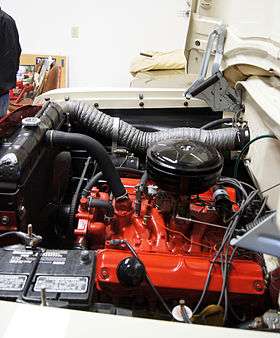Chrysler A engine
The Chrysler A engine is a small-block V8 gasoline engine built by Chrysler with polyspherical combustion chambers. It was produced from 1956 until 1967, when it was replaced by the wedge-head LA engine. It is not related to the hemispherical-head Hemi engine of the same era.
 | |
| Overview | |
| Manufacturer | Chrysler |
| Also called | Plymouth A engine |
| Production | 1956-1961 |
| Layout | |
| Configuration | V8 |
| Displacement |
|
| Cylinder bore |
|
| Piston stroke |
|
| Block material | Cast iron |
| Head material | Cast iron |
| Valvetrain | OHV 2 valves x cyl. |
| Combustion | |
| Fuel system | 4-barrel Carburetor |
| Fuel type | Gasoline |
| Oil system | Wet sump |
| Cooling system | Water-cooled |
| Output | |
| Power output | 240–290 bhp (179–216 kW) |
| Chronology | |
| Predecessor | Polyspheric engines |
| Successor | Chrysler LA engine |
The A engine was first released in 1956, and was used exclusively in Plymouths until 1958. The cylinder bore center distance is 4.46 in (113.3 mm), larger than the earlier Dodge-based poly engines. The A engine formed the conceptual design basis of its successor, the LA engine.
Plymouth
277
The 277 was the first A-block engine, produced for 1956 and sharing almost nothing but the basic concepts with other engines built by Chrysler. Bore is 3 3⁄4 in (95.3 mm) and stroke is 3 1⁄8 in (79.4 mm; 3.13 in) for a piston displacement of 276.1 cu in (4,525 cc). It was replaced by the 301 in 1957, except for in low-priced Plaza models where it continued to be used during the 1957 model year.[1]
301
The Plymouth 301 replaced the 277 in 1957. Its piston displacement is 300 cu in (4,919 cc), owing to its 3.91 in (99.3 mm) bore. These dimensions are entirely different from the 1955 Chrysler 301.
303
The 1956 Plymouth 303 displaces 302.5 cu in (4,957 cc) and uses the same connecting rods as the 277; the bore is 3 13⁄16 in (96.8 mm; 3.81 in) and the stroke is 3 5⁄16 in (84.1 mm; 3.31 in).
This engine was used in the following vehicles:
- 1956 Dodge Custom Royal (Canadian)
- 1956 Chrysler Windsor (Canadian)
- 1956 Plymouth Fury, 240 bhp (179 kW) with 4-barrel carburetor
- 1957 standard on all 118 in (3,000 mm)-wheelbase Dodges and Plymouths
313
A 313 cu in (5,121 cc) version of the A engine called the 313 was produced from 1957 to 1967 primarily for Canadian and export markets. This engine has a bore of 3.875 in (98.4 mm) and the common 3.3125 in (84.1 mm) stroke, and was used in the following vehicles, amongst others:
- 1957 Canadian Dodge Custom Royal
- 1957–1964 Australian Chrysler Royal
- 1958–1967 standard or available in all Canadian-market Dodges and Plymouths except Valiants, Barracudas, and Darts.
- 1961–1963 Bristol 407
- 1963–1965 Bristol 408 Mark I
318
The 318 is the most common version of the A engine, produced from 1957 through 1967 when it was replaced in all markets by the LA 318. Only Plymouth used this 318 in 1957 and 1958, but it was shared with the other Chrysler divisions from 1959 on. It displaces 318.2 cu in (5,214 cc) and has a 3.91 in (99.3 mm) bore and the 3.3125 in (84.1 mm) stroke.
A special 1957-'58 version called the V-800 used two four-barrel carburetors to produce 290 bhp (216 kW), making it the highest-output A engine. It was used in the 1957 and 1958 Plymouth Fury, but was also an option on Plymouth models lower in the model range.
Bristol Cars introduced the 318 in the Mark II model of their 408 (in 1965) and continued to use it in the succeeding 409 and 410 until 1969. From 1962 until early 1965, Checker used this engine for their Aerobus limousines.[2]
Non-Plymouth
326
The 326 was launched in 1959. Its actual piston displacement is 325.25 cu in (5,330 cc) but it was marketed as a 326 to avoid confusion with the Dodge Red Ram 325. The 326 uses the same 3 5⁄16 in (84.1 mm) stroke as the 318, but with the largest bore of any A engine at 3 61⁄64 in (100 mm; 3.95 in). It uses hydraulic tappets, unlike the earlier A engines, and was used in the 1959 Dodge Coronet.
References
- Lee, John (1990). Standard Catalog of Chrysler, 1924-1990. Iola, WI: Krause Publications, Inc. pp. 390–391. ISBN 0-87341-142-0.
- Naul, G. Marshall (1999). Ron Kowalke (ed.). Standard Catalog of Independents: The Struggle to Survive Among Giants. Iola, WI: Krause Publications, Inc. p. 35. ISBN 0-87341-569-8.